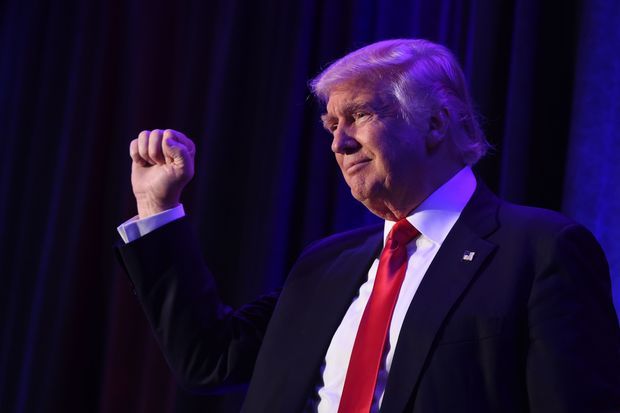
Time may be running out to expose the effort to overthrow Trump, which began before his election.
President-elect Donald Trump in New York, Nov. 9, 2016.
Photo: saul loeb/Agence France-Presse/Getty Images
The U.S. is in a constitutional crisis. It began on the day of President Trump’s election, when unelected bureaucrats mobilized against his presidency. This is a crisis in the executive branch, perpetrated by subordinate officials who don’t see themselves as answerable to the president. They have effectively established a fourth branch of government—a permanent, unaccountable bureaucracy.
The first public display of insurrection began with leaked transcripts of Mr. Trump’s phones call with Mexican President Enrique Peña Nieto on Jan. 27, 2017, and Australian Prime Minister Malcolm Turnbull the following day. As the Senate Homeland Security Committee reported, the Trump administration was plagued with 62 leaks possibly endangering national security in its first 125 days, compared with nine such leaks under George W. Bush and eight under Barack Obama. In 2019 a “whistleblower” upped the ante by leaking details of Mr. Trump’s phone call with Ukrainian President Volodymyr Zelensky. This fueled Mr. Trump’s impeachment in December.
Between those examples of mutiny against the president, corrupt actors within the Federal Bureau of Investigation—and apparently, based on recent disclosures, other parts of the intelligence community—used their power to sabotage the administration. Their actions can only be described as an attempted coup—as the Ukraine whistleblower’s attorney, Mark Zaid, did in a Jan. 30, 2017, tweet: “#coup has started. First of many steps. #rebellion. #impeachment will follow ultimately.”
Throughout this constitutional crisis, many journalists abetted the plotters by abandoning even the pretense of objectivity and claiming that Mr. Trump poses a grave threat to the country. These members of the press were willing recipients of leaks that created and perpetuated the false narrative that the Trump campaign colluded with Russia. Not one member of the media has exposed these sources of false information. They know who the leakers and plotters are; they won’t tell you.
Newsletter Sign-up
Opinion: Morning Editorial Report
All the day's Opinion headlines.
SUBSCRIBE
Fortunately, there are people who are working to uncover the truth. Former House Intelligence Committee Chairman Devin Nunes, Attorney General William Barr, former acting Director of National Intelligence Richard Grenell, his successor, John Ratcliffe and my committee, along with the Senate Finance and Judiciary committees, are working to declassify important information and make it public. Unfortunately, uncovering the truth isn’t easy, and time may be running out. Should Joe Biden win the presidency, the truth may be hidden forever.
Here’s what we know so far: On July 5, 2016, then-FBI Director James Comey overstepped his authority and publicly exonerated Hillary Clinton while criticizing her conduct. The same day in London, the FBI met with Christopher Steele, author of the now-debunked anti-Trump dossier.
U.S. intelligence agencies received reporting that Russians believed Hillary Clinton approved a plan on July 26, 2016, to “stir up a scandal” by tying Trump to the Russian hacking of a Democratic National Committee email server. Then-CIA Director John Brennan later briefed President Obama about this reporting. Also on July 26, a “friendly foreign government” gave the chargé d’affaires at the U.S. Embassy in London information that George Papadopoulos “suggested the Trump team had received some kind of suggestion” that Russia might release information damaging to the Clinton campaign, according to a December report from the Justice Department’s inspector general.
At that time, according to public reports, Gina Haspel, now CIA director, was the agency’s chief of station in London. On July 31, 2016, the FBI opened Crossfire Hurricane, its intelligence probe into the Trump campaign, based on the Papadopolous information.
The FBI received Mr. Steele’s initial reports on July 5, 2016. The bureau soon became aware the Steele dossier was opposition research compiled and paid for by the Democratic National Committee and Clinton campaign. By October 2016, the FBI was aware that one of Mr. Steele’s subsources worked for Russian intelligence services. In December 2016, the FBI learned that Mr. Steele’s primary subsource was someone it had investigated in 2009 as a suspected Russian asset.
In January 2017, the FBI interviewed the primary subsource, who described his reporting as the kind of conversation you’d have “with friends over beers.” Around that same time, the FBI received intelligence reporting that the Steele dossier contained Russian disinformation. Yet in March 2018, the FBI briefed the Senate Select Committee on Intelligence that information in the Steele dossier was reliable.
We have reached the moment of truth. For years, our efforts to obtain documents and testimony from federal intelligence agencies, including the FBI and CIA, have been stonewalled. Now Mr. Trump has authorized his subordinates to declassify and provide all information relevant to our investigations. Will they comply with his directive, or will the insurrection continue? We will hear howling and screaming that the president is politicizing the agencies and threatening national security. But what is the greater threat to our democracy—transparency, or the continued coverup of an attempted coup against the duly elected president?
Mr. Johnson, a Republican, is a U.S. senator from Wisconsin and chairman of the Homeland Security and Governmental Affairs Committee.

